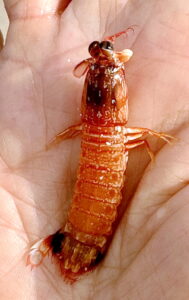
September 8, 2023
During my early morning windward beach walks, I occasionally find baby mantis shrimp lying along the waterline stranded on the sand. When the youngsters drift too close to the break, they get tossed ashore.
Few other beach walkers notice the shrimp, or recognize them as the astonishing marine animals that they are, because at this stage of life, the creatures are transparent. To see one, the sun has to strike it at a certain angle, and even then, a one-inch-long shrimp looks like a strip of cellophane.
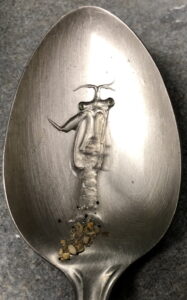
I brought this, and several other, live larval-stage mantis shrimp home to take pictures. Craig later released them off the Kailua boat ramp. ©Susan Scott
When the animals are still wiggling, we launch them back to their ocean home where we hope they will grow up to live out their amazing lives. Live long and prosper, I say as I let go, wondering if any of our rescues survive.
Well, one did, maybe. Last week, I found a beached, 2-inch-long mantis shrimp in its adult form, still wiggling. The creature could have been a youngster or may have been an adult. Hawaiʻi’s 17 species, all called aloalo in Hawaiian, range in size from 1-to-14 inches long.
Because I wanted to get a rare hands-on look at a live mantis shrimp, I took a chance and picked it up, hoping that the stressed creature wasn’t up to its usual punch.
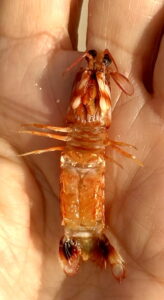
My find, possibly a shortnose mantis shrimp (Odontodactylus brevirostris), a smasher, wiggled its legs, but those front claws remained folded. ©Craig Thomas
About 450 species of mantis shrimp live in burrows on the floors of the world’s warm coastal waters. The folded front claws (mantis shrimp get their name from the praying mantis insect) of some species are smashers, the larger of those able to break aquarium glass with lightening-speed strikes. Others are slashers, their front claws like little serrated switchblades.
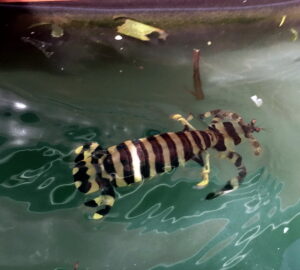
This giant, or banded, mantis shrimp, (Lysiosquillina macula) was swimming along the hull of Hōkūlea in a Bali marina. This slasher, growing to 14 inches long, also inhabits Hawaiʻi waters. ©Craig Thomas
The smashing or punching shrimp use their clubs to clobber crabs. Slashers spear fish or anything else unlucky enough to swim by. If a human foot or hand gets near a knife-blade claw, be forewarned. The slashers are also called “thumb splitters.”
In addition to their remarkable fists, mantis shrimp have the most advanced eyesight of any animal. The two independent eyes swivel, scanning the surroundings with superior depth perception. Mantis’s superb eyes can distinguish ultraviolet as well as polarized light, and have various filters to enhance the quality of available light.
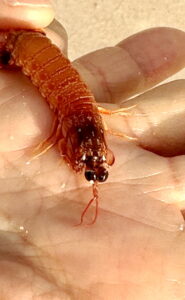
We can only guess at the psychedelic world these creatures live in. Mantis shrimp eyes have 16 color pigments. We humans have 4. ©Craig Thomas
As if brute strength and near X-ray vision aren’t enough attributes to rank these creatures among Marvel’s super heroes, mantis shrimp are up there on the intelligence pedestal with their octopus neighbors. Mantis shrimp are capable of learning, remembering, and using trickery to get food or steal a cozy burrow.
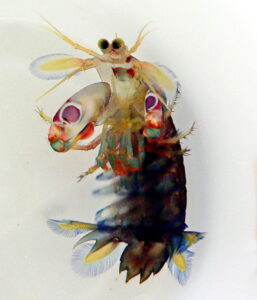
I found this well-named peacock mantis shrimp (not found in Hawaiʻi) in a container at a research station on Lizard Island, Australia. When I aimed my camera, the creature rose up to defend itself. Peacock mantis shrimp are smashers, not slashers. ©Susan Scott
My gamble that my stranded mantis shrimp wouldn’t strike paid off. If it had clubbed or cut my hand, however, it would have been worth it. Getting to hold one of the ocean’s most extraordinary life forms was a rare privilege indeed.
The YouTube video below from the James Cook University lab of my Australian acquaintence, Jamie Seymore (at right), makes me laugh every time I watch it. Take 2 minutes to be amazed not only by the shrimp, but also by these researchers’ delight in their study subjects: Slow motion mantis strikes